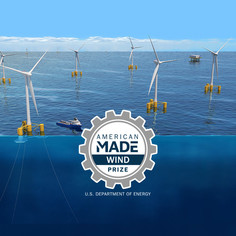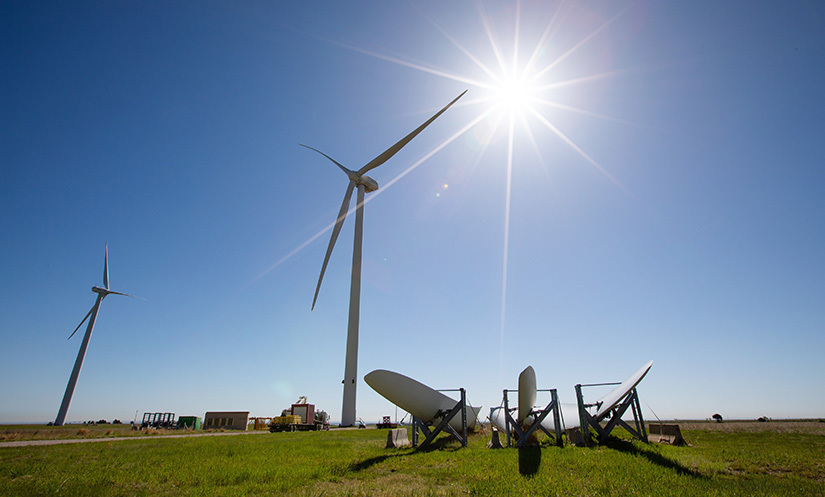Wind Energy News
New Floating Offshore Wind Energy Prize To Accelerate Domestic Supply Chain

WETO has launched the FLoating Offshore Wind ReadINess (FLOWIN) Prize, a three-phase competition to help designers, developers, engineers, fabricators, vessel operators, procurement and construction companies, logistics firms, and ports develop a supply chain and accelerate the market readiness of U.S. floating offshore wind energy designs.
Administered by the National Renewable Energy Laboratory (NREL), the FLOWIN Prize aims to help pave the way for cost-effective domestic manufacture and deployment of commercial utility-scale floating wind energy turbines in U.S. waters. Through their offshore wind energy designs, FLOWIN Prize competitors will bring the United States closer to the goals of the newly launched Floating Offshore Wind Shot™, one of DOE’s Energy Earthshots. These initiatives aim to reduce the cost of floating offshore wind energy by 70% by 2035.
Phase One of the FLOWIN Prize is open for submissions until Jan. 13, 2023. Watch the FLOWIN Prize informational webinar recording to learn more.
|
Report Analyzes How U.S. Offshore Wind Energy Industry Could Significantly Grow Its Domestic Workforce
The fast-growing U.S. offshore wind energy industry could help the country achieve the Biden administration’s goal to install 30 gigawatts of offshore wind energy by 2030. That growth also presents a big opportunity for the U.S. wind energy industry to create up to tens of thousands of jobs, according to a new report from NREL.
“This report is like a workforce equation. You have demand relative to supply,” said Jeremy Stefek, an NREL researcher and coauthor of the study. “How do you make sure that industry demand and workforce supply are aligned?”
This big workforce opportunity comes with some big unknowns. Like, for example, how many domestic jobs the industry could add—and in which sectors and roles—plus what skills and trainings workers might need to fill those jobs. Now, the U.S. Offshore Wind Energy Workforce Assessment report, produced with support from WETO, offers the first national-level evaluation of the U.S. offshore wind energy industry’s workforce gaps and opportunities.
The report examines what the blossoming offshore wind energy industry might need to grow a domestic workforce as well as what educational opportunities are needed to train that workforce. The authors also offer specific actions that the industry and other stakeholders could take to capitalize on this huge workforce opportunity.

Market Reports Show Continued Growth for U.S. Wind Energy
The wind energy market continued to grow in the United States in 2021, providing low-cost clean energy to millions of Americans. DOE released three market reports that provide an overview of developments in different sectors of the U.S. wind energy market.
The three reports include:
The land-based and distributed wind energy market reports cover trends in wind energy development, technology, cost, and performance from January 2021 through the end of 2021. The offshore wind energy market report covers trends from January 2021 through December 2021 globally and through May 2022 for the United States.
These reports present a unique combination of publicly available, confidential, and proprietary data. They provide unbiased, independent, public reporting of the current state of the industry and provide insight into multiyear trends.
NREL Researchers Point to Path for Improved Wind Turbine Blade Recycling Rates
|
 An estimated 10,000–20,000 wind turbine blades are expected to reach the end of their service annually between 2025 and 2040. NREL researchers are working on strategies for recycling these wind turbine blades. In a new iScience article, titled “Regional Representation of Wind Stakeholders’ End-of-Life Behaviors and Their Impact on Wind Blade Circularity,” they reveal the new publicly available Circular Economy Wind Agent-based Model, which takes into account behavioral factors in end-of-service decisions regarding wind energy technologies and components.
New Tool Documents Available Technologies for Monitoring and Mitigating Effects of Wind Energy Development
With support from WETO, the International Energy Agency Wind Technology Collaboration Programme’s Task 34, Working Together to Resolve Environmental Effects of Wind Energy, was established to facilitate international collaboration and advance global understanding of potential environmental effects of wind energy. To further this effort, the Task 34 team is developing the free, online Wind Energy Monitoring and Mitigation Technologies Tool to serve as a reference of available technologies and tools that can monitor and mitigate the potential impacts on wildlife of land-based and offshore wind energy development. Check out the tool’s Tethys webpage to learn more information, including on how to submit technologies for inclusion in the tool.
DOE Issues Notice of Intent for Forthcoming $28 Million Funding Opportunity to Address Wind Deployment Barriers
Lowering costs and addressing barriers to the deployment of wind energy—including offshore, land-based, and distributed—is imperative to achieve the Biden-Harris administration’s goal of a carbon-free electricity sector by 2035. Supported by the Bipartisan Infrastructure Law, an upcoming $28 million funding opportunity will:
- Develop innovative zoning and permitting processes to make distributed wind energy more accessible to community members in localities where distributed wind energy can be cost-effectively and equitably deployed
- Advance understanding of offshore wind community impacts and help affected communities more effectively participate in and capture benefits from offshore wind energy development
- Advance high-voltage direct current technologies needed for offshore wind energy transmission
- Improve technologies designed to deter bats from interacting with wind turbines.
For more information on this, as well as a Request for Information on floating offshore wind energy anchors and mooring, read the DOE press release.
Visit WINDExchange for more wind energy news.
In Case You Missed It
Offshore Wind Energy Basics: Technology Below the Water
In this webinar from WINDExchange’s Offshore Wind Energy Basics webinar series, wind energy experts from NREL and the University of Massachusetts Amherst discussed below-the-water offshore wind energy technology, including foundations and cables. Watch the webinar recording to take your offshore wind energy knowledge deeper!
Events
Offshore Wind Energy Basics Webinar: Navigating Offshore Wind Energy Decision-Making Processes
Webinar: Oct. 27, 2022, 1–2 p.m. ET, Online
In this webinar, wind energy experts will present a high-level summary of decision-making processes for offshore wind energy siting and permitting. Part of WINDExchange’s Offshore Wind Energy Basics webinar series, this webinar will focus on the points at which community leaders, property owners, coastal residents, and other local stakeholders can meaningfully engage with these processes. See what you’ll learn and how to attend the webinar on the WINDExchange website.
Speakers will include:
- Karen Baker, chief of the Office of Renewable Energy Programs at the U.S. Department of the Interior’s Bureau of Ocean Energy Management
- Jennifer McCann, director of U.S. Coastal Programs at the University of Rhode Island
- Kris Ohleth, executive director at the Special Initiative for Offshore Wind
- Suzanne MacDonald, senior researcher at DOE's NREL.
Energy Improvements in Rural or Remote Areas Workshops
Eastern U.S. Workshop: Oct. 26–27, 2022, Little Rock, Arkansas
Virtual Workshop: Nov. 1–2, 2022, Online
Join DOE’s Office of Clean Energy Demonstrations to discuss how clean energy demonstration projects will improve the resilience, safety, reliability, availability, and environmental performance of rural and remote energy systems throughout the country. The final two workshops in a series of three, these workshops will provide an opportunity to hear about energy challenges and the types of projects that can improve rural or remote energy systems. Register to attend and learn how clean energy is supporting rural and remote areas.
14th Wind Wildlife Research Meeting
Meeting: Nov. 15–17, 2022, Kansas City, Missouri
The biennial Wind Wildlife Research Meeting provides an internationally recognized forum for conservation scientists, researchers, consultants, federal and state officials, nongovernmental representatives, and industry professionals to share the latest science on wind energy and wildlife. Meeting attendees will discuss strategies for better understanding wind energy’s impact on wildlife, as well as solutions to avoid, minimize, and offset impacts.
Visit the WINDExchange calendar to learn more about upcoming events.
|